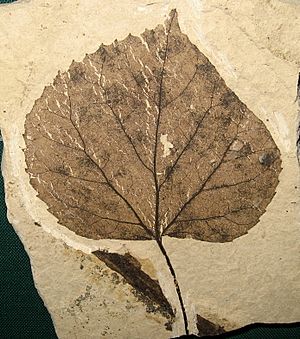Tilia johnsoni facts for kids
Quick facts for kids Tilia johnsoni |
|
|---|---|
 |
|
| Fossil leaf of T. johnsoni | |
| Scientific classification | |
| Genus: |
Tilia
|
| Species: |
johnsoni
|
Tilia johnsoni was an extinct plant, meaning it no longer exists today. It was a type of flowering plant in the same family as modern linden trees. In some places, linden trees are called "lime trees" or "basswood trees." Scientists know about Tilia johnsoni from fossil leaves. These leaves were found in rocks that are about 49 million years old. They were discovered in northern Washington state in the United States and in British Columbia, Canada.
Contents
Discovering Ancient Linden Trees
Scientists have found fossil leaves of Tilia johnsoni in two main places in North America. One place is the Klondike Mountain Formation near Republic, Washington. The rocks there are about 49 million years old. The other place is the Quilchena area, near Merritt, British Columbia.
Scientists have also found tiny fossil pollen from Tilia trees in many other places. These include sites in the Okanagan Highland region. Some of these sites are near Princeton, British Columbia, Falkland, and Kamloops. Other finds were made at the Hat Creek Amber site and Driftwood Canyon Provincial Park near Smithers.
How Old Are These Fossils?
Most of the fossil sites in the Okanagan Highland region are from the Early Eocene epoch. This was a time period that started about 56 million years ago and ended about 34 million years ago. Scientists use special dating methods to figure out the exact age of the rocks. Some sites are known to be from the Ypresian age, which is part of the Early Eocene.
Naming Tilia johnsoni
Tilia johnsoni was named and described from a single fossil leaf. This special leaf is called the holotype (meaning the main example). It is kept in the Burke Museum in Washington. Another part of the same leaf is at the University of California Museum of Paleontology.
Two scientists, Jack A. Wolfe and Wesley C. Wehr, studied this fossil leaf. They found it in the Republic, Washington area in the early 1980s. In 1987, they officially named and described the new species in a scientific book. The name johnsoni was chosen to honor Kirk Johnson. He was a young helper to Wolfe and Wehr, and he is now the director of the National Museum of Natural History at the Smithsonian Institution.
At the time, T. johnsoni was the oldest large fossil (macrofossil) of a linden tree ever found. Older tiny pollen fossils of Tilia have been found from around the time when the Paleocene and Eocene epochs met. Also, fossil fruits from a plant related to Tilia have been found in England from the Eocene period.
What the Tilia johnsoni Leaf Looked Like
The main fossil leaf of Tilia johnsoni shows us what this ancient plant looked like. The leaf had veins that spread out like fingers from the base, similar to the palm of a hand. The overall shape of the leaf was round, almost like a circle. The base of the leaf was heart-shaped, and the tip was pointed.
The edges of the leaf had teeth that were spaced out evenly. These teeth had rounded dips between them. The veins inside the leaf were also very clear. There was a main vein in the middle, with three pairs of large side veins branching off it. Smaller veins branched off these larger ones, creating a network across the leaf. This network of veins formed small, neat patterns of five-sided and four-sided shapes.

